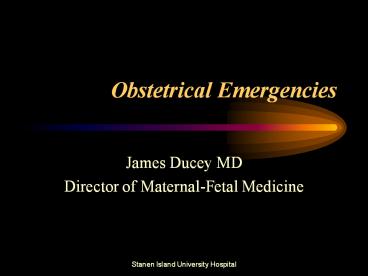Obstetrical Emergencies - PowerPoint PPT Presentation
1 / 20
Title:
Obstetrical Emergencies
Description:
Obstetrical Emergencies James Ducey MD Director of Maternal-Fetal Medicine Definition A suddenly developing pathologic condition in a patient, due to accident or ... – PowerPoint PPT presentation
Number of Views:1207
Avg rating:3.0/5.0
Title: Obstetrical Emergencies
1
Obstetrical Emergencies
- James Ducey MD
- Director of Maternal-Fetal Medicine
2
Definition
- A suddenly developing pathologic condition in a
patient, due to accident or disease, which
requires urgent medical or surgical therapeutic
intervention
3
Common Emergencies
- Hypertensive Disorders
- Hemorrhage
- Trauma
- Shoulder Dystocia
- Umbilical Cord Prolapse
- Acute Abdomen
4
Uncommon Emergencies
- Sepsis
- Respiratory Failure
- Heart Failure
- Renal Failure
- Aplastic anemia
- ITP and HUS
5
Immediate Obstetric Hemorrhage
- Cause
- Lacerations
- Atony
- Abruptio
- Retained placenta
- Previa Accreta
- Rupture
- Inversion
- Incidence
- 18
- 120-150
- 180-1150
- 1100-1160
- 1200
- 12000-12500
- 16400
6
Lacerations
- First thing to be ruled out in bleeding post
partum woman with a firm uterus - Careful examination of the entire genital tract
- Rarely results in massive blood loss
- May be life threatening if extends to the retro
peritoneum
7
Atony
- Most common cause of significant blood loss and
blood transfusion - Generally responds to uterine massage and
uterotonic drugs - Hemabate 250 micrograms IM every 15 mins. very
effective, not more than 8 doses
8
Abruption
- Delivery is generally indicted unless the fetus
is very premature and both the mother and fetus
are stable - DIC occurs in 4-10 of cases and usually is
apparent by 8 hours after onset if symptoms - Renal failure is the most common cause of
maternal mortality
9
Previa
- Transvaginal ultrasound is highly accurate in
making diagnosis (PPV 93, NPV 98) - Preterm delivery frequently needed due to
excessive blood loss or fetal compromise - Amniocentesis to documents fetal lung maturity at
36 weeks in stable patients prior to c/section
10
Accreta
- Absence of decidua basalis and imperfect
formation of the fibrinoid layer (Nitabuch) - Inccreta in myometrial invasion
- Perccreta the placenta goes through to the serosa
- Most frequently seen now when a woman with a
previous c/section has placenta overlying the
uterine scar.
11
Rupture
- Frequently the result of uterine scar disruption
- Incidence has increased with the increase of
c/sections and VBACs - Blood loss is usually not severe
- Surgical repair usually satisfactory
12
Inversion
- Usually occurs when the placenta is fundally
implanted - Dont attempt to deliver placenta until there
have been signs of separation - Prompt replacement is generally easier.
- Halothane or nitroglycerine are effective agents
- Uterotonics then needed to contract the uterus
13
New Therapies
- B-Lynch Brace Suture
- Angiography and selective embolization
- Recombinant activated Factor VII
14
B-Lynch Suture
- Br J Obstet Gynecol 1997 CB Lynch describes a
simple technique that he and others have reported
excellent success - Patient is placed in a modified lithotomy
position with the abdomen open to visually asses
the bleeding - If bimanual uterine compression controls the
bleeding the suture is placed
15
B-Lynch Suture
- 2 chromic on a rounded needle is used
- The suture punctures the uterus in the lower
uterine segment 3 cm from the lateral edge,
enters the endometrial cavity and emerge s 2 cm
superior (in the region of the lateral edge of a
low transverse c/s scar if that had been
performed)
16
B-Lynch Suture
- The suture is then passed over the fundus 3-4 cm
medial to the cornua - It is then placed through the posterior wall of
the uterus transversely at the same level of the
anterior placement - It is the passed over the opposite cornua and
through the anterior lower segment mirroring the
opposite side and tied across the midline
17
Arterial Embolization
- J Reproductive Med 1987 Feinberg etal reported a
case of delayed postpartum bleeding successfully
treated with this technique - There have been several series now published that
have established the effectiveness and safety
18
Recombinant Activated Factor VII
- Novoseven is FDA approved for bleeding episodes
in hemophilia patients - It has been effective in nonhemophiliac patients
with extensive organ damage, hemorrhage and
coagulopathy that did not respond to transfusion
19
Recombinant Activated Factor VII
- Arch Gynecol Obstet 2003 Segal etal Israel
- 3 Ob cases with severe bleeding unresponsive to
surgery and massive transfusion - Dose 90-100micrograms/kg
- Bleeding stopped in 2 cases and reduce in 1
- All patients survived
20
Recombinant Activated Factor VII
- Obstet Gynecol 2004 Merchant etal New Mexico
- 3 cases of HELLP with liver hematoma
- Bleeding was controlled in all cases with
Novoseven































